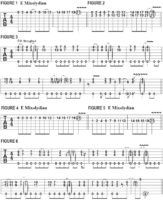
Harmonizing a Melody Over a Pedal Tone
In our previous examinations of drone-based licks, we explored ways to play single-note melodies against open-string pedal tones. This month, I’ll show you how to harmonize a melodic line over an open-string drone. One of the cool things about doing this is that it serves to emulate the sound of an open tuning by suggesting chordal sounds. It’s a little more challenging to achieve this kind of sound in standard tuning, but once you have the concept and technique down, the benefit is that you can emulate an open-tuning sound in any key.
For this lesson, let’s stick with using our open low E string as a pedal tone/drone, and we will devise melodic lines based on the E Mixolydian mode (E F# G# A B C# D). Keep in mind that the tonality reflected by the Mixolydian mode is a dominant-seven sound, so in the key of E, the harmonic reference is E7 (E G# B D).
Let’s begin with melodic pairs of notes, played thirds apart on adjacent strings, starting with the top two. FIGURE 1 shows E Mixolydian played up the high E string to the 21st fret. If we harmonize each of these notes a third below, the first note, the open high E, would be harmonized by C#, on the B string’s second fret. Just as you ascend through all of the scale degrees of E Mixolydian on the high E string, starting from E, you can do the same on the B string, starting from C#, and play diatonically to—within the scale structure of—E Mixolydian, moving from C# to D, E, F#, G#, A, etc. When played as pairs, thirds apart, the note combinations are C# and E, D and F#, E and G#, F# and A, etc., as illustrated in FIGURE 2.
Once you’ve memorized the pattern and shapes of thirds in E Mixolydian on the top two strings, you can craft harmonized melodies, which you can play over the open low E pedal tone. FIGURE 3 offers an eight-bar example of this approach, with thirds played up and down the top two strings, sounded over the rearticulated open low-E drone. I perform this example fingerstyle, picking the low E string with my thumb, and the top two strings with my index and middle fingers.
Now let’s move the concept down to the B and G strings. FIGURES 4 and 5 illustrate the E Mixolydian mode played up the neck on each of these strings individually, and FIGURE 6 is an eight-bar example of a two-note harmonized melody played on these strings, again over an open low E pedal tone. Notice that the melody is phrased in a syncopated rhythm, with accents falling on many of the upbeats, which balances nicely against the steady eighth-note drive of the low-E pedal tone.
Source: www.guitarworld.com











